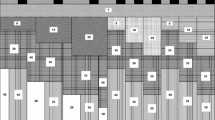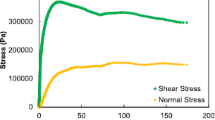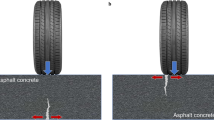Abstract
Cracking in asphalt pavements is a complex problem that is affected by pavement structural design, material properties, and environmental conditions. It is now well accepted that load-related top-down fatigue cracking (i.e., cracking that initiates at the surface of the pavement and propagates downward) commonly occurs in asphalt pavements. Conventional fracture mechanics-based finite element analysis must assume the location of macrocrack initiation a priori and, therefore, is not appropriate for general-purpose cracking simulation. This paper presents the use of the layered viscoelastic pavement analysis for critical distresses (LVECD) program to evaluate 18 pavements in local condition regions of 9 in-service pavement sites in North Carolina. In order to obtain the material properties of the individual layers from the field-extracted cores, dynamic modulus tests and simplified viscoelastic continuum damage tests are performed using small geometry specimens obtained from 150 mm diameter cores. This study verifies the capability of the LVECD model to capture crack initiation locations, propagation propensity, and cracking severity by comparing the simulation results with the observations of field cores and the field condition survey of in-service pavements in North Carolina. Overall, the agreement rate between the field core observations and field condition survey and the predicted LVECD simulation results is about 78 % in terms of cracking direction and severity.




Similar content being viewed by others
References
Baek CM (2010) Investigation of Top-Down Cracking Mechanisms Using the Viscoelastic Continuum Damage Finite Element Program. Ph.D. Dissertation, North Carolina State University, Raleigh, NC
Chabot A, Chupin O, Lydie D, Denis D (2010) Viscoroute 2.0: a tool for the simulation of moving load effects on asphalt pavement. Road Mater Pavement Des 11(2):227–250
DeBeer M, Fisher C, Jooste FJ (1997) Determination of pneumatic tyre/pavement interface contact stress under moving loads and some effect on pavements with thin asphalt surfacing layers. In: 8th International Conference on Asphalt Pavements, Vol. 1, University of Washington, Seattle, pp 179–227
Eslaminia M, Guddati MN (2011) Fourier-finite element analysis for pavement performance modelling. In: 11th US National Congress on Computational Mechanics, Minneapolis, MN, July 25–29
Eslaminia M, Thirunavukkarasu S, Guddati MN, Kim YR (2012) Accelerated pavement performance modeling using layered viscoelastic analysis. In: Proceedings of the 7th International RILEM Conference on Cracking in Pavements, Delft, The Netherlands, pp 20–22
Hopman PC (1996) The Visco-Elastic Multilayer Program VEROAD. HERON, 41 (1)
Huang YH (2003) Pavement analysis and design, 2nd edn. Prentice Hall, Englewood Cliffs
Jackson N, Puccinelli J (2006) Long-term pavement performance (LTPP) data analysis support: National Pooled Fund Study TPF-5(013)-Effect of Multiple Freeze Cycles and Deep Frost Penetration on Pavement performance and Cost. Publication FHWA-HRT-06-121. FHWA, U.S. Department of Transportation
Kim YR, Guddati MN, Underwood BS, Yun TY, Subramanian V, Savadatti S (2009) Development of A Multiaxial Viscoelastoplastic Continuum Damage Model for Asphalt Mixtures. Publication FHWA-HRT-08-073. FHWA, U.S. Department of Transportation
Kutay ME, Gibson NH, Youtcheff J, Dongre R (2009) Use of small samples to predict fatigue lives of field cores: newly developed formulation based on viscoelastic continuum damage theory. Transportation Research Record. J Transp Res Board, No. 2127, National Research Council, Washington, DC, pp 90–97
Li X, Gibson NH (2013) Using small scale specimens for AMPT dynamic modulus and fatigue tests. J Assoc Asph Paving Technol 82:579–615
Matsuno S, Nishizawa T (1992) Mechanism of longitudinal surface cracking of asphalt pavement. In: 7th International Conference on Asphalt Pavements, Vol. 2, University of Nottingham, United Kingdom, pp 277–291
Park HJ, Kim YR (2013) Investigation into the top-down cracking of Asphalt pavements in North Carolina. Transportation Research Record, No. 2368, Nartional Research Council, Washington, DC, pp 45–55
Park HJ (2013) Investigation of primary causes of load-related cracking in asphalt concrete pavement in North Carolina. Ph.D. Dissertation, North Carolina State University, Raleigh, NC
Perdomo D, Nokes B (1993) Theoretical analysis of the effects of wide-base tires on flexible pavement using circly. Transportation Research Record, No. 1388, National Research Council, Washington, DC, pp 108–119
Underwood BS, Heidari AH, Guddati MN, Kim YR (2005) Experimental investigation of anisotropy in asphalt concrete. Transportation Research Record, No. 1929, National Research Council, Washington, DC, pp 238–247
Underwood BS, Kim YR, Savadatti S, Thirunavukkarasu S, Guddati MN (2009) Response and fatigue performance modeling of ALF pavements using 3-D finite element analysis and a simplified viscoelastic continuum damage model. J Assoc Asphalt Paving Technol 78:829–868
Underwood BS, Eslaminia M, Thirunavukkarasu S, Guddati MN, Kim YR (2010). Asphalt Concrete Pavement Response and Fatigue Performance Modeling using Advanced Techniques. In: Proceedings of the 11th International Conference on Asphalt Pavements, ISAP, Nagoya, Japan, August
3D-Move Analysis Software—Version 2.1 (2013) University of Nevada, Reno, Nevada
Acknowledgments
The authors would like to acknowledge the financial support from the North Carolina Department of Transportation under project NCDOT HWY-2010-01.
Author information
Authors and Affiliations
Corresponding author
Rights and permissions
About this article
Cite this article
Park, H.J., Eslaminia, M. & Kim, Y.R. Mechanistic evaluation of cracking in in-service asphalt pavements. Mater Struct 47, 1339–1358 (2014). https://doi.org/10.1617/s11527-014-0307-6
Received:
Accepted:
Published:
Issue Date:
DOI: https://doi.org/10.1617/s11527-014-0307-6




